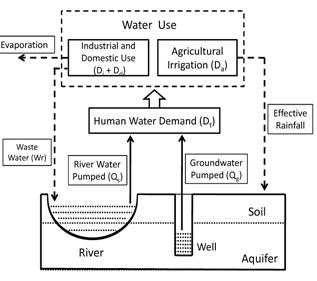Owing to population growth and economic development, human water demands are increasing rapidly and water is becoming scarce in many regions worldwide. However, continually pumping groundwater each year for consumption causes not only a local decline in the groundwater table, but also alters the water cycle and energy budget, which ultimately affects the regional climate. In this study, a groundwater exploitation scheme is incorporated into the regional climate model, RegCM4, and the climatic responses to anthropogenic alteration of groundwater are then investigated over the Haihe River Basin in Northern China where groundwater resources are overexploited. The scheme models anthropogenic groundwater exploitation and water consumption, which are further divided into agricultural irrigation, industrial use and domestic use. This study has been accepted by Climate Dynamics, the lead author is Ph.D student Zou Jing at LASG, and coauthors are Dr. Xie Zhenghui at LASG, Ph. D student Yu Yan at LASG, Dr. Zhan Chengsheng at Institute of Geographic Sciences and Natural Resources Research and Sun Qin at LASG.
The results reveal that the groundwater exploitation and water consumption cause increasing wetting and cooling effects on the local land surface and in the lower troposphere, along with a rapidly declining groundwater table in the basin. The cooling and wetting effects also extended outside the basin, especially in the regions downwind of the prevailing westerly wind, where increased precipitation occurs. The changes in the four exploitation simulations positively relate to their different water demands and are highly non-linear. The largest changes in climatic variables usually appear in spring and summer, the time of crop growth. To gain further insights into the direct changes in land-surface variables due to groundwater exploitation regardless of the atmospheric feedbacks, three off-line simulations using the land surface model Community Land Model version 3.5 are also conducted to distinguish these direct changes on the land surface of the basin. The results indicate that the direct changes of land-surface variables respond linearly to water demand if the climatic feedbacks are not considered, while non-linear climatic feedbacks enhance the differences in the on-line exploitation simulations.

Figure: Framework of simulated human-induced water resource exploitation and consumption process. The water is pumped from rivers and underground aquifers to meet the demand, and the demand is divided into industrial, domestic and irrigation water. The water consumed by industrial and domestic sections partly increases local evaporation and partly return into water channels. The water consumed by irrigation is treated as effective rainfall reaching the soil surface.
More information at :
http://link.springer.com/content/pdf/10.1007%2Fs00382-013-1995-2.pdf
